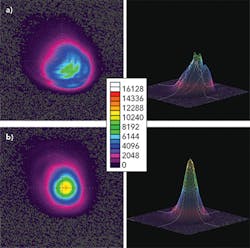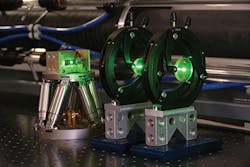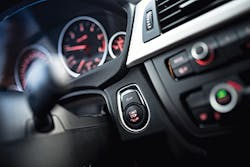Laser applications for printing and embossing
What do a beverage can, a banknote, and the interior of a car have in common?
MARKUS BOHRER
The industrial market for processing large-scale films has seen dramatic changes since the 1980s and has almost completely been replaced by lasers and digital processes. A commonly used technology for engraving screens in the printing industry, well known since then, is the use of RF-excited CO2 lasers with a beam power up to about 1kW modulated in accordance to the pattern to be engraved (FIGURE 1). A mesh is covered with a thin polymer layer and the modulated laser beam engraves this layer, where holes in the mesh have to be opened. This is a very efficient way to produce printing plates and cylinders, especially when it comes to high-volume printing. Almost all printed textiles, carpets, wallpapers, and some features of banknotes use this technique.
Direct modulation of CO2 lasers is limited to about 10kHz, which is mainly due to metastable nitrogen—a major part of the laser gas mixture. Current printing technologies used in tube and can printing demand a much higher pulse frequency of some-hundred kilohertz. The reason for that is, to a lesser extent, the higher resolution rather than the need for real 3D structures in the material. Whereas engraving meshes is basically a 2D process, engraving printing plates and rollers of polymer or rubber is a 3D engraving process with complex structures. Each direct engraved structure needs a solid foundation for stabilization during printing and may have a sophisticated geometry on top, such as a well-defined plateau and an undercut to compensate for dot gain.
Future needs for high-security printing (banknotes, security papers, passports, etc.; FIGURE 2) will require at least half a megahertz or even more, and industry now wants photorealistic pictures in packaging design, which requires a similar performance.
Acousto-optic modulators (AOMs) offer the possibility to control the laser beam in a much faster way than by direct modulation of the discharge of the laser with the RF sources. But AOMs have limits due to their absorption in the germanium crystal and their damage threshold. To get the best out, the AOMs, the laser source, and the beam path have to be well designed.
All state-of-the-art lasers are tested, especially concerning pulse behavior, power stability, pointing stability, and mode. The rise and fall time determines the pulse behavior and, thus, the engraving speed. The nitrogen in the gas mix slows down the pulse frequency to around 10kHz. This was sufficient for many applications in the past, but it is not enough for the future. A typical laser power vs. time diagram shows deviation values between ±5 and 10%. This is absolutely not suitable for a controlled 3D engraving into the depth of the material. Laser pointing stability is surprisingly good for various tested lasers and has a direct impact on the use of AOMs, which are sensitive on incident angles.
Near the power limit of the AOM, the germanium crystal is very sensitive to bad laser modes. Hot spots cause a distortion of the outgoing beam and can easily destroy the crystal. A behavior of many CO2 lasers is the bad mode in the near-field. Typically, the distance between the output coupler and the AOM should be around 2 m or more, which results in a much better mode (FIGURE 3). This is sometimes difficult to realize, especially in a compact engraving machine.
The new CO2 laser project
An obvious choice was to achieve a highly stable resonator and a close-to-perfect beam mode, using a "classic" folded CO2 laser with modern materials like carbon fiber for the resonator structure. Carbon fiber tubes can have a very small thermal expansion coefficient (less than 1μm per meter and kelvin), especially when well designed. Design includes intensive finite-element method (FEM) calculations to optimize thermodynamical behavior [1].
Beam path optimization. A custom-built carbon fiber optics table is used for high precision of the laser resonator and the entire setup for the beam path with the AOM and the infrared (IR) cameras (PyroCams) to visualize the beam mode online. A precise measurement of the influence of the germanium crystal-especially regarding distortions-can be made with two PyroCams before and after the AOM (FIGURE 4).
Hexapod. The AOM with a germanium crystal offers a comparatively good performance with up to or even more than 600W of CO2 laser power, provided that the mode of the laser beam is close to the Gaussian shape. If the power gets too high and especially if hot spots on the crystal surface occur, it is easily damaged.
Optimizing an AOM means shaping the laser beam to a balance between a small beam spot and an intensity that is still suitable for the crystal. The smaller the beam spots, the higher the pulsing frequency. Lateral and rotational optimization has to be achieved, which is quite an effort unless the pivot point for the two translational and three rotational movements can be shifted to the centroid of the incident beam on the crystal surface. A hexapod provides this feature in a perfect way and allows movement in the range of some-tenths of nanometer. FIGURE 5 shows the central resonator distance bar of the carbon-fiber CO2 laser with the hexapod and the quick-change telescope. The beam path is lit up with a green laser pointer beam for pre-alignment.
Experiments proved the comparatively large tolerance for AOM shifts and tilts and the high sensitivity for the beam mode. A bad mode immediately leads to severe distortions of the beam, which can be detected by comparing mode results from the PyroCam after the AOM with the previous one.
Power stability is improved by a factor of 10 without any closed-loop regulation. This is a good basis for high-precision applications. Thermoelectric cooling directly for the AOM and for the resonator temperature regulation unit even improves stability.
Industrial applications
After having optimized the laser source regarding power stability (less than ±1%) and beam mode to a perfect Gaussian shape, engraving results are very accurate and repeatable (FIGURE 6).
The better the performance, the more applications can now be served effectively—especially for high-speed laser engraving rollers for embossing high-quality dashboards for the car industry, producing artificial leather, and for the previously mentioned high-security printing applications. Ongoing research was done to optimize the beam shape for the AOM to achieve faster pulses. Also, the fully closed loop control of the laser signal will be optimized and developed to an industrial state to ensure a trusted pulse. Now, what are the applications?
Cans. To get an idea of the can industry's huge impact in the beverage market, one can look at the production of cans, which exceeds 1.4 billion cans per year—just in Germany! All major multi-billion can producers have changed designs from film exposed to high-speed, laser-engraved printing plates. This gives them the ability to adapt new designs in less than a day, from the idea to being ready to print dry offset plates. On the other hand, the high resolution of direct-engraved, 3D-structured dry offset plates allows photorealistic printing on cans, which will be seen in the stores worldwide in the near future. Typically, four plates for CMYK colors and some additional spot colors are used. And in spite of a breathtaking 3000 cans per minute produced and in-line printed in multi-color mode, engraving structures around 10μm allow finest details—especially when it comes to kiss print (when the finest structures on the printing plate just smoothly contact the can in order to print the light colored areas). Engraving embossing rollers to achieve a pressed-in structure is one more trend in this industry. Amazingly enough, there is an additional trend from cans to bottles for wines.
The three big can producers (Rexam, Ball Packaging, and Crown) together have more turn-over than the whole laser industry; just imagine the impact of laser engraving applications within this single branch of consumer industry (FIGURE 7).
Cans are not the only application in the food and beverage industry by far. Just look at your next yogurt cup or its lid—it's very likely that a laser is responsible for its state-of-the-art high-resolution print.
Automotive applications. The use of lasers for engraving in the automotive industry dates back to the early laser days. The day/night design for many dashboard elements is a well-known and commonly used application. A current trend is to apply sophisticated artificial animal patterns to the dashboard (usually a scan from real skins, expanded with complex algorithms to a perfect-looking, non-repetitive surface). Every car manufacturer has a distinct design and even the various series within an automotive company have very typical designs corresponding to the type of the car, whether it's an SUV or a sports car. And besides the leatherette dashboard application, cloth for door inserts as well as seat applications are an additional focus (FIGURE 8).
Outlook
Today, direct laser engraving has certain limits regarding resolution and productivity. The combination of AOM and CO2, with its current limitation of laser power (around 600W), allows the production of around 1 m2 per hour for printing plates or rollers (at a 3D depth of 500μm), enough for many applications—but industry will demand more. And there will be more in the near future (e.g., multi-beam). Good-old film material will retire and lasers will take its place.
Results from recent leatherette material and embossing research will be spread over many products in daily life (bags, wallets) so that it will not be difficult to get into touch with laser engraving technology every day and even almost every hour. Think about it when you open the next bottle of mineral water, as the banderole is likely printed with a high-speed, laser-engraved printing plate.
REFERENCE
1. M. Bohrer, "Ultra stable carbon fibre high power CO2 laser with high quality laser beam and AOM implementation," SPIE Photonics West 2015, paper 9343-61 (2015).
Dr. MARKUS BOHRER([email protected]) is the CEO of Dr. Bohrer Lasertec GmbH, Neusiedl am See, Austria.








